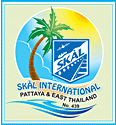- HEADLINES [click on headline to view story]:
-
Did you see a lighthouse in the storm?
-
PCEC members learn about Thai fruit
-
Thai wine challenges at IFHS Wine Challenge 2009
|
|
Did you see a lighthouse in the storm?
Dr. Iain Corness
A “Movers and Shakers” party was held last Friday at The Village
(corner of Chaiyapruek 1 and Sukhumvit Road), and was billed as a Lighthouse
Club event.
 Dr
Iain Corness interviews Cees Cuijpers (left) from Town and Country for
Pattaya Mail on TV. Dr
Iain Corness interviews Cees Cuijpers (left) from Town and Country for
Pattaya Mail on TV.
The “Movers” included principal sponsors Cees Cuijpers (Town and Country)
who has always been one of the ‘movers’ in the Pattaya scene; John Black
from the Real Estate magazine; and the ‘real’ movers JVK International
Movers, represented by prize pugilist Craig who was ready to live up to his
company’s brochure promising our “satisfaction” was his top priority. This
did impress the ladies present.
The “Shakers” would have included the 110 golfers who had finished at the
Plutaluang course and all arrived with red faces and shaking from a thirst
that would have drained the Mabprachan dam. Others at the evening’s
festivities included assorted Lighthouse Club members, with the total being
anywhere between 150 to 300, depending upon whom you asked and their degree
of sobriety, or how wet they were.
Of course, one very noticeable attendant was the always energetic Tracy
Cosgrove, who runs the Melissa Cosgrove Foundation to assist in the
education of the children of construction workers. Tracey is well aware of
the fact that education of children is their passport to a better life.
At around 7.30 p.m., the rains came down on cue, all but drowning the
lighthouse, and those who had opted to sit out in the gardens were drenched
before making it under cover. Some ladies demonstrated that white goes
transparent when wet, pre-empting the lingerie show which was on the list of
attractions for later in the evening. After the torrential downpour,
“lingerie” rapidly became a “swimsuit” show. Despite several similar shows
each night in Walking Street, there was no doubting the attraction of
semi-clothed females for the shakers that night. San Miguel assists with
night vision they tell me.
Reports to hand were that the evening was still enjoyable, despite the
weather, but the following mornings were not as pleasurable.

Lovely entertainment for the
evening.
PCEC members learn about Thai fruit
Master of Ceremonies Richard Silverberg welcomed everyone to
the regular Sunday meeting of the Pattaya City Expats Club on September 20 at
the Amari’s Henry J. Bean’s Restaurant. After the usual opening remarks, he told
the audience that Gary Brown, today’s guest speaker, was no stranger to the
club. Gary is a long time member and frequently handled the emcee duties for the
club before moving back to the USA. He is currently on a visit to Thailand and
he graciously volunteered to talk to the club about a subject he is interested
in, the many different fruits one can find in Thailand.
 Gary
Brown, now a resident of Florida, but here for a short holiday, offered to share
with PCEC members some of the things he has discovered about the fruits of
Thailand; here the coconut. Gary
Brown, now a resident of Florida, but here for a short holiday, offered to share
with PCEC members some of the things he has discovered about the fruits of
Thailand; here the coconut.
Gary started off by saying that he was not an expert on the subject. He noted
that having previously lived five years in Thailand, he often ate fruits that he
didn’t recognize and when he left Thailand, he still did not know much about
them. When asked to speak to the club, he said he chose fruits of Thailand
because he wanted to learn more about them and share the results of his research
with everyone. However, because there are so many and only a short amount of
time for the presentation, he said he would comment only on a few of them.
With the aid of pictures, Gary launched into his subject. The first was the
coconut. Gary said that the coconut (ma-phrao in Thai) is grown in many areas
around the world, mostly in a humid climate - between latitude 26 degrees north
and 26 degrees south. The Portuguese called this fruit the “coca.” The British
added the word “nut” to the name, thus calling it a coconut. Gary said that
coconut trees often grow to 30 meters in height and because they can take salty
water are found close to the sea. He described the coconut and mentioned man has
made various uses of the tree, the palm leaves, and the husks in addition to
using the fruit itself. A tree can produce up to 75 coconuts during the year and
coconuts are used as an ingredient in many Thai dishes and desserts.
He followed with the pineapple (saparot in Thai). Gary said that Spanish
explorers first discovered them in the 1500’s in Brazil and introduced them to
Europe as the piña. Gary described the pineapple and said humming birds are the
primary means of pollination. However, he said, the taste of the pineapple is
not as good if it has been pollinated. So, growers do their best to ensure their
plants are not pollinated - one reason humming birds are not allowed in Hawaii -
a major pineapple growing area.
Another well known fruit was instantly recognized by the audience. It is very
popular with Thais, notwithstanding its distinct and considered by some
unpleasant odor. Gary said the durian seems to be a fruit that some love and
others hate. Gary noted that each durian can weigh 2 to 7 pounds and the trees
can grow to 50 meters in height. The flowers and resulting fruit grow close to
the tree trunk which is better able to bear their weight. Gary mentioned there
were a substantial number of varieties of durian in Thailand and that most yield
only one or two crops a year. Many are grown near Chantaburi where they have an
annual Durian festival.
On a much smaller scale in size is the dragon fruit (kaeo mangkon in Thai). This
popular fruit comes in either white or red flesh speckled with black seeds. Gary
noted that it blooms only at night with a white fragrant flower. It is
pollinated by bats and moths. He said that it has a mildly sweet taste and is
low in calories. Also, a tea can be made from the flowers. It is a good source
of Vitamin C and is reputed to lower blood pressure and cholesterol. Gary said
if you have a “snack attack,” forget the candy, eat dragon fruit instead as it
is healthier.
Of course there is the flavorful and sweet mangosteen (mangkut in Thai). This
popular fruit, which has no kinship with the mango, is the size of a small apple
with a dark purple skin and white flesh inside. Gary cautioned that one should
be careful as the skin will stain cloth. It grows on a tree and is fertilized by
insects. He said that it is an extremely sweet fruit and is better eaten before
the seed grows too large.
In concluding his talk, Gary said he wanted to mention the long kong. It is
round with a creamy yellow skin and has a white flesh. The taste is sweet with a
slightly sour tang. He said we all have our favorites, which make living in
Thailand wonderful because there are so many to choose from. Gary received a
great round of applause from an appreciative audience.
Emcee Richard then updated everyone on upcoming events and called on Hawaii Bob
Sutterfield to conduct the always informative, interesting, and sometime
humorous Open Forum where questions are asked and answered about living in
Thailand and Pattaya in particular.
Thai wine challenges at IFHS Wine Challenge 2009
Chitra Chandrasiri
Thailand’s leading international food and hospitality trade event, the
International Food and Hospitality Show 2009 (IFHS 2009) was held at the Royal
Paragon Hall, Siam Paragon recently in Bangkok.
Despite the challenging economy this year’s show was a resounding success with
over 12,000 sqm space of the Royal Paragon Hall being transformed into an
all-in-one exhibition for the food and beverage, hotel, retail and hospitality
industries, showing a wide range of products from coffee, wine, fresh produce,
dairy products, meats, fruits, vegetables, processed foods, seasonings,
confectioneries, ice cream, snacks, to tableware, furnishings and other
hospitality equipment and technology. An array of the latest eco-friendly
innovations and management technology that help improve efficiency and
profitability for hotels and restaurants featured strongly at this year event.
 Visootha
Lohitnavy (Nikki), first female Thai winemaker / Oenologist of Granmonte winery
receives a gold medal for her wine, Granmonte Chenin Blanc 2009, from Ranjith
Chandrasiri. Visootha
Lohitnavy (Nikki), first female Thai winemaker / Oenologist of Granmonte winery
receives a gold medal for her wine, Granmonte Chenin Blanc 2009, from Ranjith
Chandrasiri.
In addition, this year IFHS 2009 was co-located with Hostec Asia, the regional
trade show and conference for hospitality and food service technology, coupled
with highlighted activities that included the International Wine Challenge
organized by the Food and Beverage Association of Thailand (FBAT), the Hotel
Congress by the ASEAN Hotel and Restaurant Association, the Restaurant Industry
Seminar by the Thai Restaurant Association, the Retail Conference by the Thai
Retailer Association, and the ASEAN Culinary Cup 2009 supported by the World
Association of Chefs Societies (WACS) - a highly prestigious event representing
Asia’s first international culinary arts contest and convention which attracted
more than 3,000 local and international chefs, delegates and industry
professionals.
Once again, the International Wine Challenge, which has proved to be a popular
competition, was held on day one. The extensive selection of international wines
was judged in 8 categories of Premium and Super Premium by a panel of wine
experts from Thailand’s wine, hotel and restaurant industries, chaired by
Ranjith Chandrasiri, president of the Royal Cliff Wine Club and the deputy
general manager of the Royal Cliff Beach Resort. As in most international wine
competitions, FBAT awards were given based on averaged scores from the judges in
categories of varietal reds, whites, blends and sparkling wine. Trophies were
presented to each category winner and the two best overall winners by
Chandrasiri at the award ceremony.
Of all the wines that entered the competition 48 scored well enough to receive
either gold, silver or bronze awards.
Thai wines put on a show of force led by GranMonte and Siam Winery entries, with
GrandMonte winning five awards, including four for their whites from locally
grown Chenin blanc and Colombard.
The gold medal winners to look for included Laurent Perrier “Brut” (Champagne
and Sparking wine category), Carta Vieja (Sauvignon Blanc), StoneFish Chardonnay
(Chardonnay), Granmonte 2009 Chenin Blanc (Blended white), Tussock Nelson
(Sauvignon Blanc), Merryvale 06 Chardonnay, Carneros (Chardonnay), Fleur Bleue
(Pinot noir), Hugo Casanova Reserva (Merlot), Swagaroo Cabernet Sauvignon
(Cabernet Sauvignon), Tree LineShiraz Cabernet (Blended red), Yali (Shiraz),
Willamette Valley Vineyard 07 Pinot Noir (Pinot Noir), Merlot Reserve “Arenal”
(Merlot), Chateau Souverain 05 (Cabernet Sauvignon), Chateau de Potiron- Cuvee
Privilege 2005 (Blended red), Shirah “Camplazens” France (Shiraz).
|
|

News | Business | Features |
Columns | Mail Bag |
Sports | Auto Mania
Our Children | Travel |
Our Community | Dining Out & Entertainment
Social Scene | Classifieds |
Community Happenings | Books Music Movies
Clubs in Pattaya | Sports Round-Up
E-mail: [email protected]
Pattaya Mail Publishing Co.Ltd.
62/284-286 Thepprasit Road, (Between Soi 6 & 8) Moo 12, Pattaya City
T. Nongprue, A. Banglamung,
Chonburi 20150 Thailand
Tel.66-38 411 240-1, 413 240-1, Fax:66-38 427 596
Copyright © 2004 Pattaya Mail. All rights reserved.
This material may not be published, broadcast, rewritten, or redistributed.

|
|

Rotary
International

www.rotary-jomtien.org

www.rotary-taksin.org

|